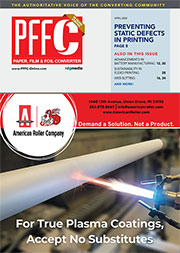Featured Stories
-
Advantages of Shear, Razor and Crush Web Slitting Techniques
When choosing a slitting method, many factors must be considered, including interaction with inspection systems. -
Revolutionizing Lithium-lon Battery Manufacturing Advances in Slot-Die and Electrode Coating Technology
As the global battery market surges toward an estimated $328 billion by 2028, innovations in manufacturing processes are becoming increasingly... -
Nordson Divisions Collaborate to Achieve Unprecedented Flat Profile Time
Nordson Measurement & Control Solutions (a division of Nordson Corporation) is a global leading provider of gauging systems for the film...
News | New Products
-
Morris Packaging to Add New KY Flex-pack Plant
Bloomington, IL-based Morris Packaging plans to build a new $60.9-million production plant in Marion County (KY), a project that will create 276 full-time jobs.
-
Press Belt Manufacturer IPCO to Focus on Engineering and Service Expertise
IPCO will use Ligna 2025 to highlight the service and support services it provides to press manufacturers and WBP producers alike.
-
INX promotes seven Executives to Vice President positions
INX International Ink Co. has announced the Board of Directors has approved the promotions of seven key people to Vice President positions.
-
Bimec and Flex CA Strengthen U.S. Market Presence with a new installation at Cello-Wrap Packaging Inc.
Bimec and Flex CA proudly announce a new milestone in their U.S. market expansion with the recent commissioning of a state-of-the-art slitter rewinder at Cello-Wrap Packaging Inc, located in Farmersville - TX.
-
New Era Converting promotes industry veteran Stephen Pickett to controls engineering manager
New Era Converting, an IPCO company, has announced that Stephen Pickett is taking on a new role as controls engineering manager.
-
Fedrigoni Announces New Slitting Center for Self-Adhesive Labels in Germany in Q4 2025
The Fedrigoni Group - a world reference in the manufacturing of self-adhesive labels, special papers for packaging and other creative applications, graphic supports for visual communication and RFID
-
Advancing Label Innovation Through Collaboration
Packaging is a physical representation of a brand’s identity, and label converters play an essential role in bringing the packaging experience to life.
Expert Advice
Workhorse Winders Do More Than Ever Before
- Published: December 01, 2001, By Claudia Hine, Senior Editor
Winding technology has gone way beyond what it was in the '90s, says Bruce Butler, VP of sales at Independent Machine Co., Fairfield, NJ. “The entire system is just way more sophisticated this year than it was even two years ago.”
The most significant changes include new control systems that use servo drives and PLC units as a means of controlling speed and machine sequencing functions, explains Don Rush, national sales manager at Elsner Engineering Works, Hanover, PA. “The ease of making adjustments using the new controls really makes the converter's life easier, as does the ability to store the memory of a particular run for a particular product and recall it at a later date for a repeat performance.”
“Everything is electronic and much more quantifiable,” adds Butler. Data acquisition capabilities allow operators to store speed and tension parameters for a particular job. “It takes the art out of the process. You store the recipes and then you get consistency time after time for that particular product.”
More sophisticated drive systems also mean the tension control is much better, he adds.
The desire for better core starts is increasing because products are getting more expensive, so waste reduction is a big factor, says Rich McCarthy, VP at New Era Converting Machinery, Paterson, NJ. “Today there's a greater variety of transfer technologies and cut types. Now it's common to use shear cutoffs, traversing knife cutoffs, and enveloping cutoff systems. There are various technologies available for no fold-over and no tape transfers. Some of these technologies have been around for some time, but they're being applied more often and at higher speeds. Converters want to handle difficult materials more automatically and at higher speeds.”
When writing specs for new equipment, McCarthy recommends converters consider what materials they might run in the future, because the ability to handle other materials can be built into a machine from the start, or the ability to modify it in the future can be built in. “If you've got a product that doesn't need a lay-on roll, and you build a machine without it or without provisions to add one, you might be cutting off your future,” he warns. “You can buy a machine that does gap winding, but you design it so it can do gap winding and pack winding.”
Butler cautions, however, converters must work with the OEM when writing specs. Otherwise, he says, “When you're trying to build a machine to do everything, you have to make it so generic it's not going to do anything great.”
For winding material that's subject to wrinkling, McCarthy says constant geometry winding really minimizes or eliminates the rewinding challenge of wrinkle formation just prior to the transfer. “Constant geometry means there are two sets of pack or gap rolls, one dedicated to each winding position, and they rotate with the turret,” he explains. “That means that the geometry of the web path leading to the winding roll stays constant through the entire cycle and doesn't get lost during the transfer. It gives you a better roll.”
Down the road, Rush predicts, winder manufacturers will improve their current lines even more, offering equipment with controls that are more operator friendly than they are today and that run at higher speeds than currently available.
That workhorse winder has become a thoroughbred.













